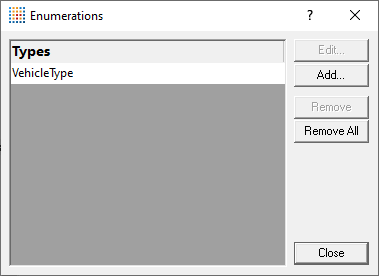The Datatypes and enumerations tab allows you to:
•scan headers to look for datatypes including typedefs, structs and enumerations
•define or edit data not able to be determined automatically
The Show data at... feature of the Memory tab uses these definitions to inspect allocated memory using a meaningful interpretation of the data.
 If you don't define any datatypes or definitions here then memory inspection will just show the same format as the Show Data at (bytes)... option.
If you don't define any datatypes or definitions here then memory inspection will just show the same format as the Show Data at (bytes)... option.
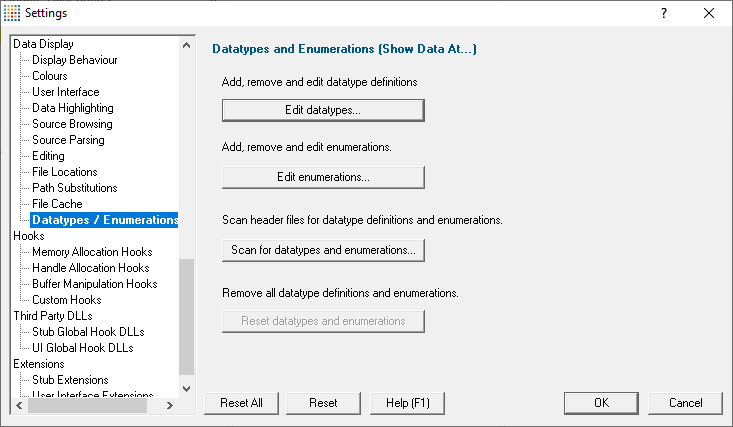
•Edit datatypes...  shows the Datatypes dialog to edit existing datatypes or add new ones
shows the Datatypes dialog to edit existing datatypes or add new ones
•Edit enumerations...  shows the Enumerations dialog to edit existing enums or add new ones
shows the Enumerations dialog to edit existing enums or add new ones
•Scan for datatypes and enumerations...  shows the Scan for Datatypes dialog to extract definitions from header files
shows the Scan for Datatypes dialog to extract definitions from header files
•Reset datatypes and enumerations  clears any definitions previously defined or found in headers
clears any definitions previously defined or found in headers
 Don't accidentally click the Reset button at the bottom of the page as that will reset all settings!
Don't accidentally click the Reset button at the bottom of the page as that will reset all settings!
You can define standalone datatypes and enumerations, as well as those to be used in more complex datatypes.
 Make sure you click OK not Cancel on the global settings dialog when you're done or you'll lose any changes.
Make sure you click OK not Cancel on the global settings dialog when you're done or you'll lose any changes.
Definitions will persist between sessions.
Datatypes Dialog
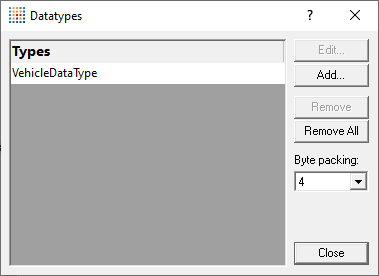
•Add...  shows the Define Data dialog to add a new definition
shows the Define Data dialog to add a new definition
•Edit...  opens the Define Data dialog to modify or just review an existing definition
opens the Define Data dialog to modify or just review an existing definition
•Remove  removes any selected datatypes from the list
removes any selected datatypes from the list
•Byte packing  sets the number of bytes into which the datatype is to be packed and aligned
sets the number of bytes into which the datatype is to be packed and aligned
Enumerations dialog
The enumerations dialog is almost identical to the Datatypes dialog above:
•Add...  shows the Define Enumeration dialog to add a new definition
shows the Define Enumeration dialog to add a new definition
•Edit...  opens the same dialog to modify or just review an existing enum
opens the same dialog to modify or just review an existing enum
•Remove  removes any selected enumerations from the list
removes any selected enumerations from the list
Defining a new datatype
To define a new datatype you need to enter the name of the structure, and details about each member.
 You'll need to define any referenced types first before you define a structure that uses it.
You'll need to define any referenced types first before you define a structure that uses it.
We'll demonstrate the datatype definition with the following examples:
enum VehicleType
{
VehicleType_Car = 0,
VehicleType_Bus = 1,
VehicleType_Van = 2,
VehicleType_Lorry = 3,
VehicleType_Bicycle = 4,
VehicleType_Motorbike = 5,
VehicleType_Scooter = 6,
VehicleType_Skateboard = 7
};
struct VehicleDataType
{
int numWheels;
char* strMake;
double realEngineSize;
enum VehicleType enumType;
CObject* ptrOwner;
};
•Edit datatypes...  Datatypes dialog
Datatypes dialog  Add
Add  shows the Define Data dialog
shows the Define Data dialog
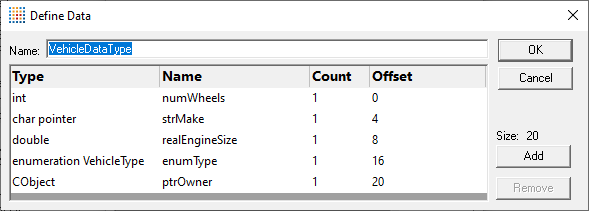
•Name  specify the name of the datatype, VehicleDataType
specify the name of the datatype, VehicleDataType
•Add  appends a new row to the data to define a new member
appends a new row to the data to define a new member
Double click to show the drop down list in the Type column if not already shown.
The list has many core datatypes and will include any datatypes you've already defined.
If the type is an enumeration, you'll be prompted for the name of the enumeration which you should have already defined.
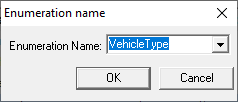
Enter the name of the data member in the Name column.
If more than one, Specify how many items the member represents in the Count column, e.g. for an array.
 Values in the Offset column will be calculated automatically.
Values in the Offset column will be calculated automatically.
•Remove  removes any selected data members from the list
removes any selected data members from the list
Defining a new enumeration
•Edit enumerations...  Enumerations dialog
Enumerations dialog  Add
Add  shows the Define Enumeration dialog
shows the Define Enumeration dialog
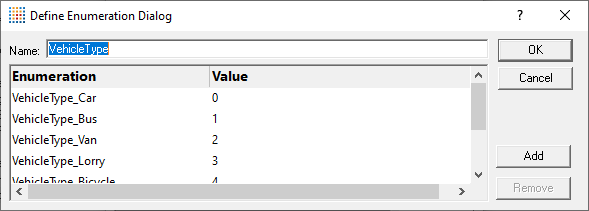
 Any enumerations defined here can be used in the Define Data dialog above.
Any enumerations defined here can be used in the Define Data dialog above.
•Name  specify the name of the enum, VehicleType
specify the name of the enum, VehicleType
•Add  appends a new row to the data to define a new member
appends a new row to the data to define a new member
Enter the name of the member in the Enumeration column.
Set the corresponding value in the Value column
•Remove  removes any selected members from the list
removes any selected members from the list
Scanning for datatypes
You can scan header files to find definitions for datatypes or enumerations which are not otherwise detectable.
•Scan for datatypes and enumerations...  shows the Scan for Datatypes dialog
shows the Scan for Datatypes dialog
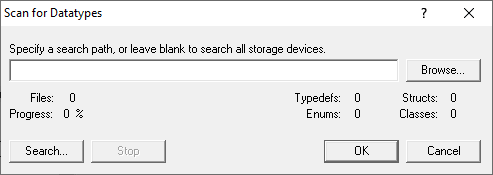
•Browse...  type or browse to enter a directory or drive to scan for header files from which to extract datatypes
type or browse to enter a directory or drive to scan for header files from which to extract datatypes
Leave this blank to scan all available drives.
•Search...  start header file scanning
start header file scanning
•Stop  stop the search at any time
stop the search at any time
•Cancel  discard the results of the search and close the dialog
discard the results of the search and close the dialog
Any datatypes found during the scan are added to the lists in the datatypes dialog or the enumerations dialog.
 At the time of writing, scans don't detect datatypes inside classes and 64 bit datatypes are not supported.
At the time of writing, scans don't detect datatypes inside classes and 64 bit datatypes are not supported.
Reset All - Resets all global settings, not just those on the current page.
Reset - Resets the settings on the current page.
